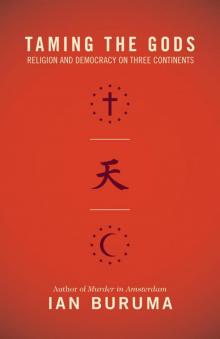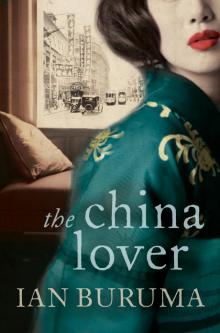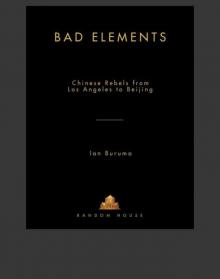- Home
- Ian Buruma
A Japanese Mirror Page 13
A Japanese Mirror Read online
Page 13
As she grows up, however, she feels increasingly awkward: ‘How was she to explain it? If they would just leave her alone … If only she could go on playing house forever, with her dolls for companions, then she’d be happy again.’ She begins to understand, very vaguely at first, why she was always treated so kindly by the proprietor of her sister’s establishment.
One day Shota sees her in front of the teahouse with ‘coloured ribbons in her hair and tortoise-shell combs and flowered hairpins. The whole effect was as bright and stately as a Kyoto doll.’ A neighbourhood boy remarks that she looks even prettier than her sister, but he certainly hopes she will not end up like her. ‘What do you mean?’ Shota replies, ‘That would be wonderful! Next year I’m going to open a shop, and after I save some money I’ll buy her for a night!’30
‘He didn’t understand things,’ is Ichiyo’s wry comment.
Midori, alas, does. That is her tragedy. Her childhood dreams slowly come apart. She has to accept her fate. None of this is directly stated by Ichiyo. All is implied. The last image of the story is typical of her style: it is indeed the sort of image Japanese artists have used for centuries, and still do, even in popular modern films (the line between hoary cliché and high art is a fine one): ‘One frosty morning, a paper narcissus lay inside the gate. No one knew what it was doing there, but Midori took a fancy to it, for some reason, and put it in a bud vase. It was perfect she thought, and yet almost sad in its crisp, solitary shape.’
Growing Up is not a criticism of prostitution as such. Ichiyo was too cynical and too detached for straight social criticism, and she was certainly no prude. If it is against anything, it is against the lack of freedom to choose one’s own destiny in Japanese society. What is truly tragic is the way people are bound to fate; all the more so because the Meiji restoration, in its early years, had promised change.31 But soon society became almost as rigid as it had been under the Tokugawas. Ichiyo’s response is a combination of Saikaku’s irony and a Heian sense of pathos.
Troubled Water (Nigorie), also written in 1895, actually takes us inside an even lower kind of brothel than the one for which Midori was destined. Ichiyo’s description of some of its inhabitants is hardly inviting: ‘She was a woman of perhaps twenty-seven, perhaps thirty. She had plucked her eyebrows and painted a dark line in their place and had outlined her widow’s peak in black. A thick layer of powder covered her face. Her lips were rouged a shade of crimson so deep they lost their charm and suggested more a man-eating dog than a courtesan.’
The story is about one prostitute in particular: Oriki, the number one attraction at the Kikunoi House. A merchant named Genshichi is so devoted to her services that he spends all his money on her, ruining his business and leaving his family destitute. She has another admirer called Yuki Tomonosuke, a wealthy, suave playboy, who is ‘different from other men’. He becomes her confidant, listening patiently to all her woes. She tells him about all the men she has to be nice to, and how they sometimes propose to marry her. But she doubts that would be the answer. Tomonosuke, though, is not like that; she really likes him:
‘When I don’t see you for a day, I miss you. But if you asked me to be your wife, I don’t know … I doubt it would work, and, yet, when we’re not together … In a word, I suppose you could say I’m fickle. And what do you think made me this way? Three generations of failure, that’s what.’32
Like Midori, and almost every Japanese heroine or hero, she cannot escape her fate.
How she hated her life! She never wanted to hear another human voice, or any sound at all … How long would she be stuck in this hopeless situation, where everything was absurd and worthless and cruel … ‘I have no choice,’ she whispered. ‘I will have to cross the bridge by myself. My father fell treading it. They say my grandfather stumbled too. I was born with the curse of many generations … Oh, it doesn’t matter any more what happens –I haven’t the slightest idea what will become of me – I might as well go on as Oriki of the Kikunoi … With my station in life and my calling and my fate, I’m not an ordinary person any more. It’s a mistake to think I am. It only adds to my suffering. It’s all so hopeless and discouraging. What am I doing standing here? Why did I come here? Stupid! Crazy! I don’t even know myself,’ she sighed. ‘I’d better get back.’33
This is the voice of Oriki of the Kikunoi. It is also the sort of thing one hears ‘salarymen’ say on a drunken evening; it is what their wives, pushed into marriages with men they hardly knew, often say. It is, in fact, what many Japanese are liable to say in their more melancholy moods.
Choice of one’s destiny, though doubtless wider than it was in Ichiyo’s time, is still subject to severe limitations. People in Japan, more than in any Western country, are still ruled by the demands of their social environment. This is, in effect, what is meant by fate-the pressure to conform to expectations. Although the prostitute, in her self-abandonment, is in a sense freer than the rest of us, she is also the most dramatic victim of this predicament. It is this paradox that speaks so vividly to the Japanese imagination: she is a sacrificing mother, a victim of fate and free from the usual social conventions, all at the same time.
In 1950, a much younger writer called Yoshiyuki Junnosuke, carrying on the tradition of brothel literature, had a very similar point of view. In Street of Primary Colours (Genshoku no Machi) a prostitute named Akemi tries but fails to escape her fate. The quarter itself has changed considerably since Ichiyo’s days, along similar lines to Japan itself:
Both sides of the main street were inundated with strong, garish colours. A red neon light flickered inside a heart-shaped fluorescent tube. Pink curtains hung down from doorways of Western-style houses in front of which several women with bright red nails and lips were listlessly hanging about …
Painted lips moved rapidly up and down; white teeth reflected the neon lights. Bare arms stretched out to grab arms, coats, and even hats of men strolling by. Making meaningless sounds and cracking silly jokes, the men stopped to take a better look at the women: everyone to his own taste. They would then be taken inside, or they would disentangle themselves and walk on to the next place …
The relationships in the area were quite clear. As far as the women were concerned, however pretty and naive they might have looked, they still bore the marks of their profession. The men would look at them without even wondering whether they would respond to their advances; they would simply be calculating how much pleasure they could get for their cash …
Some people were attracted to these streets by a certain sense of freedom. The girl called Akemi who lived in one of the houses there was one of them. Or, rather, her position made it impossible for her to find freedom anywhere else. This, at least, was how she rationalized her actions …
In fact Akemi falls into the same trap that had claimed so many of her literary – and no doubt real – predecessors for centuries: she falls in love – with an employee of a shipping company, named Motogi Hideo. She experiences her first orgasm with him. Unfortunately, however, ‘Motogi Hideo lost interest as soon as he saw that Akemi had ordinary emotions like everybody else’. In other words, she stopped being simply an image, a popular piece of art with painted lips.
Akemi conforms to another classic convention too: she tries to commit suicide with the man she loves. In an attempt to drown them both, she drags him overboard at a launching party. They are saved, however, and when Akemi comes to her senses and sees everybody staring at her, ‘she knows she’ll return to those streets again’.
Higuchi Ichiyo’s story, Troubled Water, ends with a murder of passion as well but a ‘successful’ one. Oriki of the Kikunoi is found by gossiping neighbours:
… slashed across the back, down from the shoulder. There were bruises on her cheek and cuts on her neck. She had wounds all over! Obviously she tried to flee, and that’s when he killed her.
He, on the other hand, did a splendid job of it! Hara-kiri and the whole business. Who would have thought he had it in him? …
He died like a man. Went out in a blaze of glory.
What a loss to the Kikunoi.
Yes. Think of all the men she attracted! To let all those customers slip through your fingers!34
Love is the death of the courtesan. In the case of Chikamatsu’s seventeenth-century heroines, their deaths were at least made to seem noble, demonstrating the purity of their love. Even the most hopeless cases could still be redeemed by sacrificial beauty. In modern Japan this beauty has somehow lost its bloom. The sordidness of reality is harder to escape.
But why this tyranny of fate? Why is there this deep sense of tragedy in everything these heroines do? Oriki is held back by the failures of her ancestors. She cannot imagine herself in any situation but the one she finds herself in. And there is nothing she can do about it.
Yoshiyuki, like Ichiyo, an author of rare psychological insight, comes to a conclusion which, again, could serve as a metaphor for the Japanese way of life:
The reason they always return to the streets must be sought in the women themselves … As long as their consciousness is not severed from their environment, that is, from their way of life, living by selling their bodies, such words as freedom and bondage are irrelevant. There are plenty of stories of idealistic men attempting to change this consciousness. But these attempts must always end in failure.
The same thing could be said about most Japanese. While they remain in Japan, their lives and the way they define themselves are impossible to separate from their Japaneseness. The personal is often indistinguishable from the collective. In practice this may be true of most people in the world, but in the West at least one has the idea-perhaps the illusion-of being an individual amongst other individuals, together but separate, like islands in a sea of islands.
In Japan one’s identity seems to be defined to a greater extent by the social environment and one is responsible to that environment only. This could be a motorcycle company, a baseball team, a theatre group, or even the entire country; all depending on the time and place. The point is that one cannot really exist separately from these groups without risking severe psychological problems. Writers, because of the nature of their work, are sometimes forced to take this risk. This is one way of explaining the many suicides of authors in recent times.
It also explains why it appears to be so difficult for many Japanese to return to the national fold once they have left it for any length of time. Alienation in Japan is a very high price to pay. Not conforming to the expected pattern means essentially that one does not exist at all. This is why Japanese companies abroad often discourage their Japanese employees from mixing with the ‘natives’ (genchijin) too much. For, to turn Yoshiyuki’s sentence round, separating one’s consciousness from the Japanese way of life makes such words as freedom and bondage at once extremely relevant.
From midnight on 31 March 1958, public prostitution was officially banned for the first time in Japanese history. Fifty-five thousand girls (not counting the many unregistered prostitutes) all over the country found themselves out of a job. The first reaction to the new law was rather charming and very Japanese: just before the midnight deadline prostitutes and their customers all over Tokyo began singing ‘Auld Lang Syne’, a hugely popular song in Japan, appropriated for those deliciously sad occasions, so dearly beloved by the Japanese people, of saying goodbye.
This was of course not quite the end of prostitution. In many parts of the country it simply went on as before. Even in Tokyo the streets were only really ‘cleaned up’ just before the Olympic Games in 1964 to make a civilized and enlightened impression on the world. Whether the foreign visitors were pleased with this measure history does not tell.
Whether the anti-prostitution law is good or bad does not concern us here. Suffice it to say that the steady economic development of Japan made a system of virtual slavery an embarrassing anachronism. It also showed the power of crusading female pressure groups – who were largely responsible for the new law – in Japanese politics. It did not mean, however, that a fundamental change had taken place in people’s attitudes to sex. In fact, despite the new law, the image of women of pleasure in popular culture has hardly changed at all.
Bar and club hostesses, still an indispensible part of Japanese social life, serve a similar function to the courtesans of Edo. The top-ranking ones dispense their favours neither easily nor cheaply and they are still the much publicized companions of famous actors and showbiz personalities. They specialize in skilled entertaining and a rather artificial bawdy banter, which would perhaps not set most Western men alight, but is highly appreciated in Japan. But most important of all, from the lowliest masseuse to the top-flight geisha, they serve to put the Japanese male at ease, to make him forget the tensions of collective company life, to soothe his masculine anxieties, to indulge his whims and flatter his social pride. They are, perhaps increasingly, highly trained mothers.
Pure prostitution exists, too, of course. But many newly affluent Japanese now go to Bangkok, Taipei and Manila in highly organized tours, like hungry wolf-packs. They set off armed with golf clubs which they leave at the airports to be collected on the way home, so as not to seem too blatant about the purpose of their trip.
But one does not have to go as far as Manila. The cold letter of the law is one thing in Japan, and human reality quite another. As long as a degree of discretion is observed – and perhaps the right people are paid off – much is allowed to go on unimpeded. The massage parlour, for instance, the toruko, short for Turkish bath, is simply a continuation of an old tradition combining the bathhouse with the brothel: the attendants used to be called yuna, bath girls, and now they are known as torukojo, Turkish bath girls.
At first sight these places hardly remind one of the romantic past. There are no girls any more, attracting customers to their establishments by tapping them coyly on the shoulder with the long stems of their pipes, whispering risqué witticisms. Torukos, announcing themselves in loud neon lights, are instead fronted by young men in suits shouting at the taxis cruising by. For prices up to $200 one is offered a furu kosu (full course), lasting about 90 minutes. The ‘course’ comprises a wash, a soapy massage, and a series of sudsy sexual acrobatics, during which the man remains quite passive. The torukojo is after all a skilled entertainer; and she goes about her business with the same dedication as a flower-arranger. When the performance is over, she bows and politely thanks the customer for his patronage, handing him her business card.
Apart from the ceremonious behaviour, which is simply the Japanese way, there are several interesting parallels with the past. In the first place many modern torukos are situated in the old licensed areas: the brothels have simply been rebuilt to accommodate a large number of baths. Not only that, but some establishments even bear the same names as illustrious Edo teahouses, in the same way that variety-hall entertainers sometimes borrow the names of great Kabuki actors.
It is the emphasis on fantasy, however, and the attitude to the women that has hardly changed at all. If the brothels of the Edo period borrowed their fantasies from the tenth-century world of Prince Genji, the massage parlours draw from all the images in the modern world. The architecture is usually an indication of the type of illusion for sale. Some torukos have entrances built to resemble jumbo jets with wooshing jet noises switched on as one steps inside. The girls are of course dressed as stewardesses. Other places have façades resembling banks, featuring girls in company uniforms. There are ‘Young Rady’ schools with girls in tennis outfits, greeting the customers in the hall with rackets under their arms. There are hospitals with nurses, Chinese pavilions, American discos, and even a place with a jungle full of Janes in leopard-skins waiting for Tarzan to turn up. Perhaps the most bizarre of all are the fake-Japanese castles where kimonoed attendants kow-tow in front of the entrance and say ‘welcome home, my lord’.
Many of these fantasies are universal, but the limitless energy and the innocent openness with which the Japanese try to fulfil them is perhaps unique in th
e world. It is not surprising that the Turkish bath girls are treated a little like actresses, just as their sisters of the Edo period were. There is even a rigorous ranking system with girls competing to be ‘numba one’.
Another tradition still persisting is the detailed guide with information about the habits, prices and relative values of the many massage parlours. There are professional critics, called ‘torukologists’, who pontificate on late-night television shows, offering us the benefit of their expertise. Popular magazines and newspapers print weekly reports on new faces at the local torukos, and reviews of the current ‘numba ones’:
Miss Akiko: service time, one hour and twenty minutes; price: 40.000 yen ($150) Height: 175 cm. Weight: 49 k. Proportions: 83–56–85. She is a hard worker with special oral skills. Very good at creating a romantic mood. ‘I’m proud of our place,’ she says, ‘and I enjoy working hard to make it prosper.’
Miss Miwa: 90 minutes. $180. Height 160 cm. Weight 51 k. She has great confidence in her work since she came to the Yoshiwara. She likes all kind of hard play. ‘We have a very clean place,’ says this refreshing city girl, ‘and in the right mood there is no end to the service I provide. We take great pride in our good manners.’35
Finally a Miss Yuki, 83–59–86, informs us that her establishment specializes in a ‘Japanese mood’: ‘We do our best to behave with the traditional delicacy and good manners we Japanese are accustomed to.’
If one removed the references to the precise nature of their business, these could be reviews of workers in an automobile plant or the staff of a chainstore: ‘good manners’, ‘prosperity of our company’… It is a far cry from the dry ‘call Annie for French lessons’ in a British tobacconist’s window or the lewd advertisements in Western porno magazines. The torukojo somehow manages to envelop her trade with a sense of duty and decorum.

 A Japanese Mirror
A Japanese Mirror Taming the Gods
Taming the Gods The China Lover
The China Lover A Tokyo Romance
A Tokyo Romance Theater of Cruelty
Theater of Cruelty Year Zero
Year Zero The Wages of Guilt
The Wages of Guilt Murder in Amsterdam
Murder in Amsterdam Bad Elements
Bad Elements Their Promised Land
Their Promised Land Occidentalism
Occidentalism Anglomania
Anglomania Inventing Japan: 1853-1964 (Modern Library Chronicles)
Inventing Japan: 1853-1964 (Modern Library Chronicles) The Missionary and the Libertine
The Missionary and the Libertine